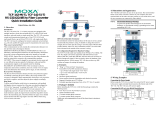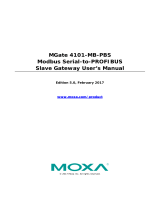
- 2 -
Overview
Introduction
The TCF-142-RM series fiber converters are slide-in modules that can
be installed in the NRack System’s rackmount chassis, such as the TRC-
190 series. The slide-in module is equipped with a multiple interface
circuit that can handle RS-232 or RS-422/485 serial interfaces, and
multi-mode or single-mode fiber. The TCF-142-RM series slide-in
modules are used to extend serial transmission distance up to 5 km
(TCF-142-M-XX-RM, with multi-mode fiber) or up to 40 km (TCF-142-S-
XX-RM, with single-mode fiber).
Why Convert Serial to Fiber?
Fiber communication not only extends the communication distance, but
also provides many advantageous features. IMMUNITY FROM
ELECTRICAL INTERFERENCE: Fiber is not affected by electromagnetic
interference or radio frequency interference. It provides a clean
communication path and is immune to cross-talk. INSULATION: Optical
fiber is an insulator; the glass fiber eliminates the need for using
electric currents as the communication medium. SECURITY: Fiber
cannot be tapped by conventional electric means and is very difficult to
tap into optically. Furthermore, radio and satellite communication
signals can be captured easily for decoding. RELIABILITY &
MAINTENANCE: Fiber is immune to adverse temperature and moisture
conditions, does not corrode or lose its signal, and is not affected by
short circuits, power surges, or static electricity.
No Configuration Required for Baudrate Settings
The TCF-142-RM slide-in modules work under any baudrate from 50
bps to 921.6 Kbps. The TCF-142-RM slide-in modules simply convert
the signal back and forth between serial (RS-232, RS-422, or RS-485)
and fiber, and since the TCF-142-RM slide-in modules do not need to
interpret the signal, it does not need to know the baudrate of the
transmitting device. For this reason, the TCF-142-RM slide-in modules
do not have any DIP switches or jumpers for setting the baudrate.
Ring Mode
To allow one half-duplex serial device to communicate with multiple
half-duplex devices connected to a fiber ring, you should configure the
TCF-142-RM slide-in modules for “ring mode” by setting DIP switch
“SW3” to the “On” position. The Tx port of a particular TCF-142-RM
slide-in modules unit connects to the neighboring converter’s Rx port to
form the ring. Note that when one node transmits a signal, the signal
travels around the ring until it returns to the transmitting unit, which
then blocks the signal. Users should ensure that the total fiber ring
length is less than 100 km when using either single-mode models or
multi-mode models.














